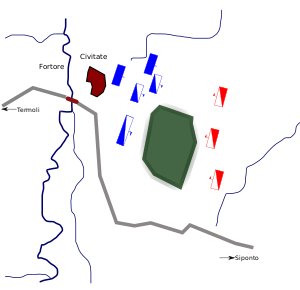Battle of Civitate
| date | June 18, 1053 |
|---|---|
| place | near Civitate, Apulia |
| output | Victory of the Normans |
| Parties to the conflict | |
|---|---|
| Commander | |
|
Gottfried III. von Lorraine |
|
| Troop strength | |
| approx. 3,500 men | about 6,000 men |
| losses | |
|
unknown |
unknown |
In the Battle of Civitate on June 18, 1053 , a Norman army defeated Pope Leo IX's papal army .
backgrounds
The Normans moved into southern Italy, following the gift of Aversa from 1030. This alarmed the Pope. In 1052 Leo IX met. , born Count Bruno von Egisheim in Alsace , with his 2nd cousin Emperor Heinrich III. in Saxony to discuss the " Norman plague " and to ask Heinrich for help. Help was only given to him in the form of a small army, which was soon called back, which subsequently drove a wedge between the German emperors and the papacy, and so Leo returned to Rome in March 1053 . Only 700 Swabians moved with him under the leadership of Count Adalbert II. Von Winterthur and his brother, the Reichssturmfähnrichs Count Werner II. Von Grüningen , as well as about 2,000 men from the population of Italy and Lombardy . He therefore endeavored to establish an alliance with the Emperor of Byzantium , which came about, and so he confidently moved south towards Siponto against the Normans . The Normans blocked his way to the Byzantines, and so the armies met on the Fortore River near Civitate, northwest of Foggia .
The battle
Since the Norman army was numerically inferior to the Pope's army, its leaders first sought their salvation through negotiations. With great confidence that the Byzantines under Duke Argyros would soon appear , the Pope had this canceled. The Normans then attacked the papal army on June 18, 1053, which had meanwhile grown to around 6,000 men, but largely consisted of foot troops. The Normans only had around 3,500 men, but most were on horseback and heavily armed.
The Normans divided into three blocks. Each block was commanded by one of the Norman counts. The center of Richard von Aversa , the right wing of Humfred von Hauteville and the left of Robert Guiscard , Humfred's brother. The papal army was commanded by Duke Gottfried von Lothringen and Rudolf von Benevento , while Count Adalbert commanded the Swabians and his brother Werner, as “ primicerius et signifer regis”, was probably responsible for the preliminary battle. The Pope himself watched the battle from Civitate.
The Norman cavalry dashed down the hill to the plains in front of the city to carry out a joint onslaught of heavy riders on the Pope's main force. Robert Guiscard stood out as a great fighter, as legend has it that he was pulled from his horse three times and always fought his way back. This successful move led to the disintegration of the papal army, so that the pope was left with almost only the Swabian counts and their infantry. These were now hopelessly inferior and without exception - including their leaders Adalbert and Werner - were struck down.
Effects
The Pope himself was captured and, during his nine-month captivity in Benevento, had to recognize the Norman counts as the rightful masters of the territories they had conquered. All counts received their territories from the Pope as a fief . How the capture took place is not entirely clear. On the one hand it has been reported that the Pope surrendered himself to avoid death, while other sites report that the city handed him over to avoid being razed . Released seriously ill, Leo IX died. on April 19, 1054 in Rome.
literature
- Jean Deuve: L'épopée des Normands d'Italie. C. Corlet, Condé-sur-Noireau 1995, ISBN 285480497X .
- Horst Enzensberger : Civitate, battle v. In: Lexicon of the Middle Ages (LexMA). Volume 2, Artemis & Winkler, Munich / Zurich 1983, ISBN 3-7608-8902-6 , Sp. 2116 f.
- Jean-Marie Martin: Italies Normandes. XIe-XIIe siècles. Hachette, Paris 1994, ISBN 201017934X .
Remarks
- ↑ Source for Cognomen : Regesta Imperii Online RI III, 5.2 n.1078 .
- ↑ The city no longer exists; it was close to San Paolo di Civitate .
- ↑ "primicerius et signifer regis" = precursor and ensign of the king.
